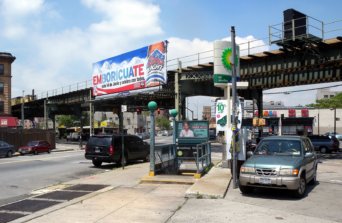- About
- Topics
- Picks
- Audio
- Story
- In-Depth
- Opinion
- News
- Donate
- Signup for our newsletterOur Editors' Best Picks.Send
Read, Debate: Engage.
| topic: | Climate action |
|---|---|
| located: | USA |
| editor: | Yair Oded |
Last week, New Yorkers in Williamsburg, Brooklyn woke up to a bewildering sight - their local subway station was completely submerged in water. It later turned out that the Metropolitan Transit Authority (MTA), the company operating the NYC subway system, purposefully flooded the station in order to test systems that were installed to protect the station against storm surges intensified by climate change.
The entrance to the station, on the corner of Broadway and Union Avenue in Williamsburg, was sealed off by a “flex gate” and completely submerged in water; in case of a superstorm, this mechanism can protect the station from up to 14 feet of water.
News of the experiment broke when a passerby named Kaye Blegvad tweeted a picture of the flooded entrance and asked the MTA for an explanation, seeing as other entrances were not sealed off and the station was operating as usual. “We’re pivoting to submarines,” the MTA tweeted back jokingly, adding in a subsequent tweet that they were conducting the “test flood” because “climate change is real.”
The MTA’s efforts to upgrade the New York transit system’s durability in the face of climate change began following Hurricane Sandy. Back in 2012, Sandy raged through the Big Apple, wreaking havoc on the city’s infrastructure; subway stations were submerged (nine of them floor to ceiling), railway lines connecting Manhattan and Long Island were flooded, and tunnels and bridges sustained extensive damage. Reparations from the storm are still being carried out to this day.
In the aftermath of Sandy, the city and MTA embarked on an effort to make New York’s infrastructure more resilient against storm surges and sea-level rise, both of which are expected to intensify in the future due to the effects of the climate crisis.
Among the various solutions developed by the MTA Climate Adaptation Task Force are 3,000-pound vault-doors that seal off stations in close proximity to the waterline, interlocking “stop logs” that can be piled on top of one another at the entrance to subway stations and heavy fabric curtains capable of blocking off the water.
Last week’s test, The Verge reported, examined a “flex gate” made of Kevlar that can be instantly put into place by a single person. 65 such gates have been installed thus far, according to a statement given to The Verge by the MTA.
But the significance of last Wednesday’s experiment extends beyond the actual testing of the new gadget; it also sends a clear message to residents of the city: climate change is happening. Now.
Walking by one’s local subway station and seeing it flooded to the brim with water has the potential of jolting urbanites out of their naivete and conveying the fact that climate change will have an increasingly tangible effect on their lives.
Particularly those of us who live in large urban centres in the western and northern hemispheres tend to feel somewhat immune to the ravages of global warming. The faster we shatter this illusion, see ourselves as part of a global community affected by this crisis, and apply pressure on both ourselves and our leaders to take meaningful action to curb our carbon footprint - the better equipped we will be to deal with this emergency and, perhaps, manage to spare ourselves from its worst effects.
Image: Jim.henderson/CC0
